Canada to allocate $600 million for new construction tech including 3D printing
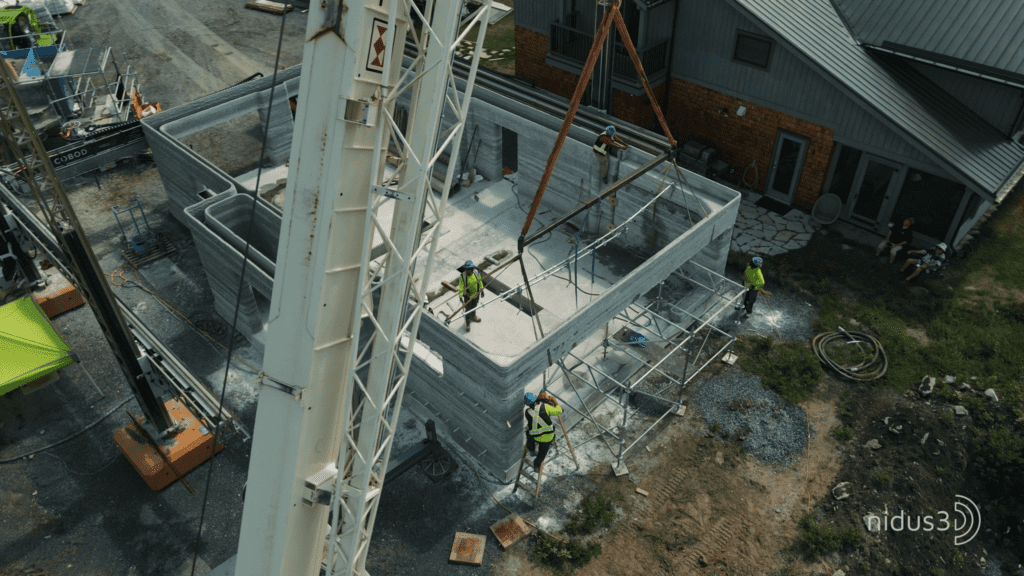
Stay up to date with everything that is happening in the wonderful world of AM via our LinkedIn community.
In countries and areas like the US, Canada, China, Russia, the Middle East or Africa, the enormous availability of land often clashes with insufficient housing. New technologies such as 3D printing can help build houses better, cheaper, more sustainably and faster. For this reason, Canadian Prime Minister Justin Trudeau has announced an over $600 million package that will research and develop new ideas and technology like prefabricated housing factories, mass timber production, penalization, 3D printing, and pre-approved home design catalogs.
“We’re changing the way we build homes in Canada,” the Rt. Hon. Justin Trudeau, Prime Minister of Canada, said in a statement. “In Budget 2024, we’re supporting a new construction approach, with a focus on innovation and technology. This will make it easier and more cost-effective to build more homes, faster. You should be able to live in the community you love, at a price you can afford.”
A 2-story building built by Canadian 3D construction printing company nidus 3D using a COBOD 3D printer.
In Canada, housing is one of the biggest pressures on people. Young Canadians are renting more than ever and being priced out of their communities. Families are finding it difficult to get a good place to settle down. Seniors are being forced to downsize. The cost to build homes is too high, and the time it takes to finish projects is too long. We’ve already taken bold action to build more homes, faster, improve access to housing, and make homes more affordable – and we know there is more to be done.
Trudeau, who is known to be very much aware of the latest technological and scientific development, said the Country needs to build more homes and needs to do so like never before, at prices Canadians can afford. That means investing in ideas and technology like prefabricated housing factories, mass timber production, penalization, 3D printing, and pre-approved home design catalogs.
The upcoming Budget 2024 introduces several measures aimed at addressing housing challenges. Among other things, it entails the establishment of a new $50 million Homebuilding Technology and Innovation Fund, to leverage an additional $150 million from private sector entities and other levels of government. This fund will facilitate the expansion, commercialization, and adoption of innovative housing technologies and materials, particularly for modular and prefabricated homes. Next Generation Manufacturing Canada will lead this initiative.
Built by Twente Additive Manufacturing (TAM), the Fibonacci house was the first 3D printed house in Canada. It was built in 2020 and is listed on Airbnb.
The budget also allocates another $50 million to streamline and modernize home-building processes through regional development agencies. This funding builds upon the progress of numerous ongoing innovative projects nationwide, including endeavors focused on modular housing, mass timber construction, robotics, 3D printing, and automation.
A significant $500 million is earmarked to bolster rental housing, offering low-cost financing via the Apartment Construction Loan Program. This support will aid new rental housing projects employing innovative construction methods, including those by prefabricated and modular housing manufacturers, alongside other homebuilders.
Additionally, a modernized Housing Design Catalogue is slated for launch to standardize up to 50 efficient, cost-effective, and livable home blueprints. With an $11.6 million allocation from Budget 2024, this catalog will encompass templates for modular homes, row housing, and fourplexes, intended to simplify and expedite housing approvals and construction timelines for housing manufacturers, provinces, territories, and municipalities.
These measures are designed to bolster made-in-Canada ideas and technologies while fostering growth in the home-building sector. They leverage innovation to facilitate the necessary scale and pace of construction to alleviate housing shortages. However, they are considered as initial steps toward more comprehensive solutions. The government plans to further engage with stakeholders from the housing, construction, and building materials sectors, as well as labor unions, experts, and other partners, to formulate a comprehensive Canadian industrial policy for homebuilding, aimed at ensuring fairness for future generations.
Trudeau pushes 3D-printed homes to solve Canada housing crisis
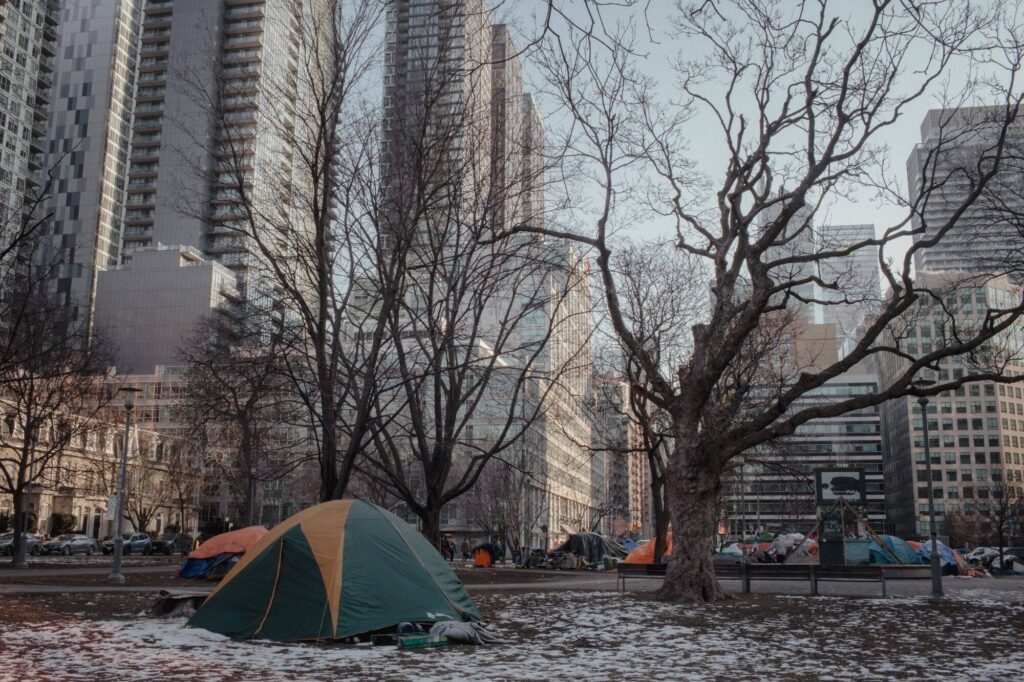
Canada’s Prime Minister Justin Trudeau announced measures aimed at making it easier and cheaper to build new homes, with an emphasis on prefabricated modular housing.The federal government will provide C$50 million (US$36.8 million) to a new fund meant to “support the scale-up, commercialisation and adoption of innovative housing technologies and materials,” Trudeau’s office said in a news release.A further C$50 million will go through regional development agencies to help modernise homebuilding “through modular housing, mass timber construction, robotics, 3D printing and automation”, the release said.Trudeau also announced C$11.6 million to support the creation of a catalogue of preapproved home designs to reduce the cost and time it takes to build housing – a strategy first used during World War II.The unhoused find shelter in makeshift tent encampments at Clarence Square park in Toronto, Ontario, Canada, in February. Photo: BloombergEarlier this week, Trudeau announced a top-up to a C$55 billion fund to provide low-cost financing for apartment building construction.On Friday he said C$500 million of that would be used for new rental housing “using innovative construction techniques from prefabricated and modular housing manufacturers”.The prime minister and his cabinet have made a series of announcements this week on housing measures that will be in the April 16 budget.Trudeau has been under fire over the past year due to Canada’s soaring cost of housing and is trailing badly in the polls to Conservative Party Leader Pierre Poilievre.Colleges face millions in losses amid Canada’s foreign student crackdownMelissa Lantsman, deputy leader of the Conservatives, described Trudeau’s pre-budget announcements as “frantic” and accused him of re-branding and recycling policies that do not get homes built.She said her party’s plan to provide a bonus to cities that increase homebuilding by 15 per cent annually – and fine those that do not – would be more effective.While Trudeau has pushed provinces and cities to allow up to four units on every lot, Lantsman said her party would allow communities to decide which types of housing work for them.“We just want to see more approvals and less gatekeepers in the way,” she said.
North America’s First 3D printed 3-Story Building
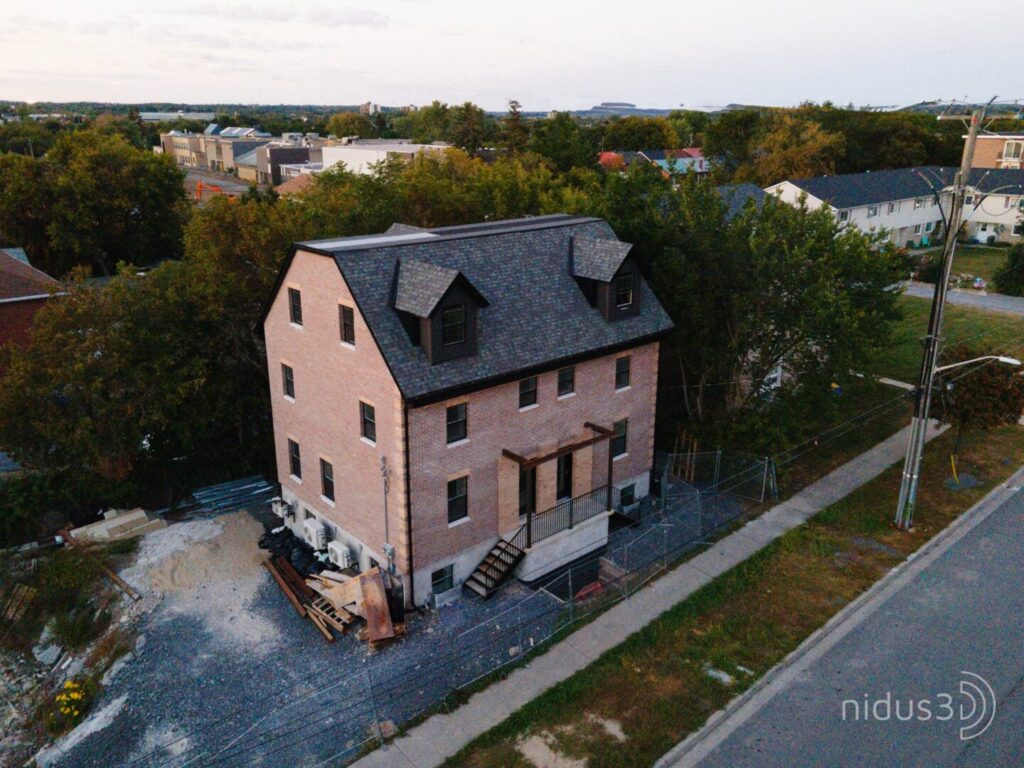
North America’s first 3D printed 3-story building has been completed near Toronto, Canada by nidus3D using a COBOD construction 3D printer. The townhouse has a usable floor area of 420 m2 (4,500 SF) and includes the world’s first 3D printed basement, a widespread feature in many Canadian and US homes in colder regions. Tenants will […]
Lafarge Canada supporting Canada’s largest 3D-printed housing project in Alberta
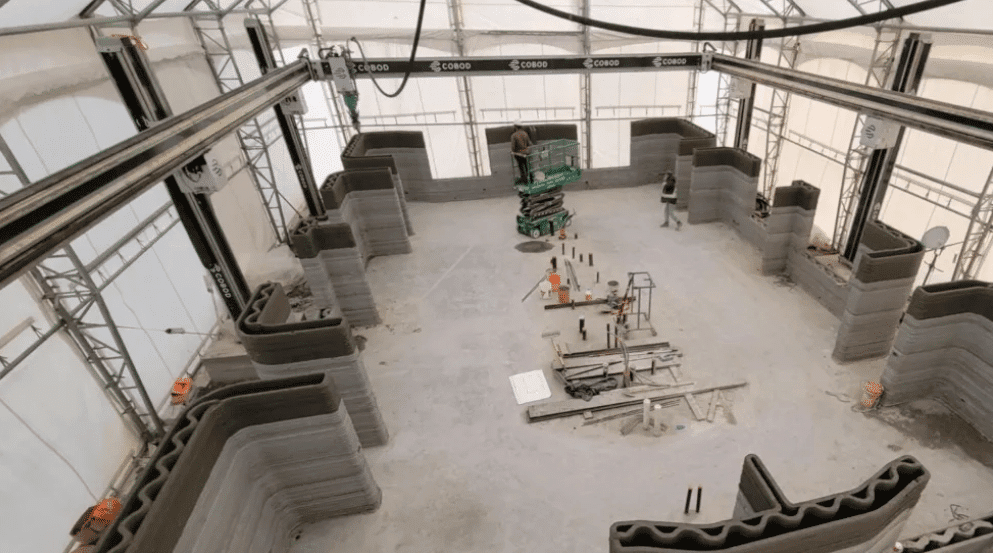
Ontario Construction News staff writer Lafarge Canada will supply its OneCem low-carbon cement and work with nidus3D to build Canada’s largest 3D-printed housing project, aimed at addressing an acute housing challenges faced by the SikSika Nation. While nidus3D has successfully completed 3D-printed housing projects in Ontario, this is the first project in Alberta. Construction is […]
SikSika Nation to Receive 3D Printed Housing Community in Canada – 3DPrint.com | The Voice of 3D Printing / Additive Manufacturing
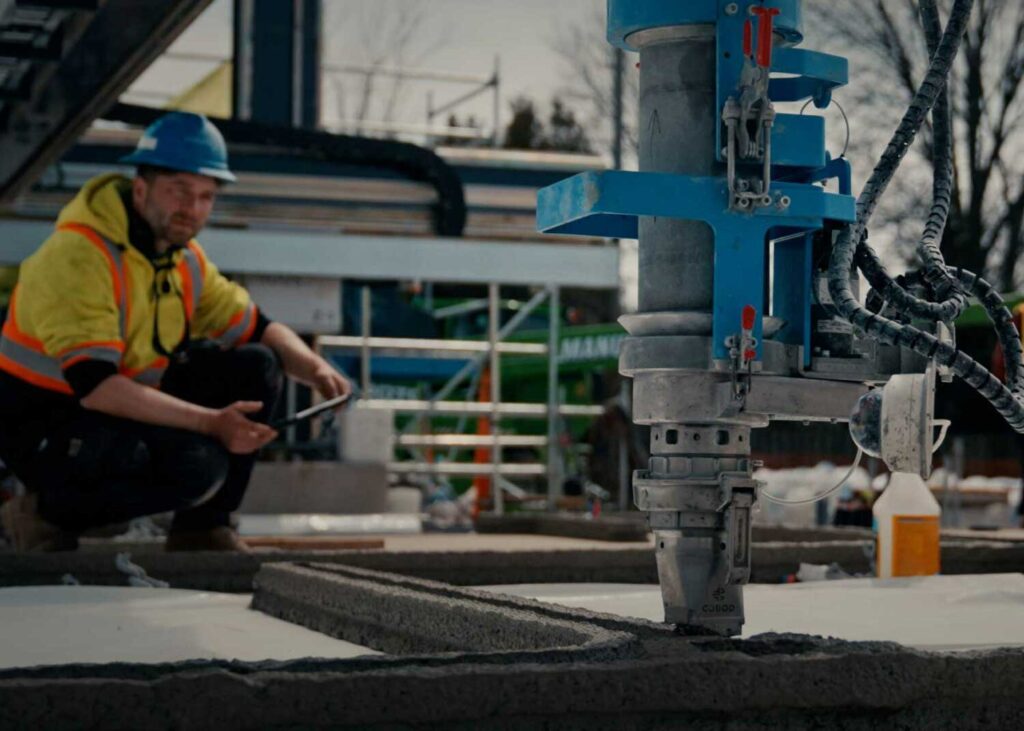
In Canada, the soaring prices of homes have become one of the if not the biggest political issue at the moment, sparking widespread interest in possible solutions like 3D printing homes. In this area, the Canadian subsidiary of French cement giant Lafarge, is collaborating with nidus3D, a on-site 3D construction service firm, to make homes in the country.
nidus3D utilizes COBOD 3D printers for its construction projects. The firm’s latest endeavor involves creating 16 housing units in the SikSika Nation, a First Nation community located in southern Alberta. This initiative is particularly noteworthy because it aims to provide shelter to individuals facing domestic violence and those at risk of homelessness.
“Our shared goal with nidus3D extends beyond mere innovation. This project is about helping address the critical housing needs of the nation and foster a resilient, inclusive future through sustainable construction practices. We were proud to contribute to this project,” stated Lafarge Canada (West) president and CEO Brad Kohl.
Lafarge plans to use its OneCem cement for the project, which is meant to be 10% less polluting in terms of emissions compared to traditional Portland cement.
“This multi-build development will not only provide much needed housing but show the immense potential of 3D construction printing to address Canada’s housing crisis. This project will demonstrate efficiencies and savings the technology can deliver through rapid, repeatable construction,” said nidus3D President Ian Arthur.
nidus has a track record of printing units for Habitat for Humanity and creating North America’s first two-story 3D printed building. This approach to construction might reduce costs for homebuilders due to its lower labor requirements. Simultaneously, it can minimize material use and significantly cut down on formwork, potentially lowering expenses and diminishing the environmental impact of home building. Nevertheless, as our Editor in Chief Michael Molitch-Hou previously pointed out, this technology is unlikely to completely solve the housing crisis.
In the past decade, house prices in Canada have more than doubled. For those fortunate enough to afford a house in a major city, mortgage payments can consume a staggering 59% of household income. In a market like Ontario, the average sold price of a home was $750,000 in December 2018, which has now escalated to over $1 million. Since 2000, house prices in the country have increased more than fourfold. While GDP per capita has doubled during this period, incomes and disposable income haven’t kept pace with the soaring house prices.
Although the entry of foreign buyers and new immigrants adds pressure to the market, the primary driver appears to be the perception of homes as a sound long-term investment. This belief, increasingly shared by individuals and firms, fuels the conviction that house prices will continue to rise. The result is a surge in investment activity, with investors buying properties and developers focusing on high-end properties. Consequently, the existing market, particularly more affordable segments, is not adequately addressed.
Currently, Canadian society lacks a mechanism to swiftly increase income or to collectively construct low-cost housing on a large scale. In contrast, post-World War II Europe saw governments actively stimulating mass house building to meet the demand. Additionally, many countries have established housing associations specifically to provide low-cost housing. It appears that Canada has yet to devise a comparable solution for its current situation. According to some estimates, the housing shortfall in Canada could exceed 3 million units by 2030.
Unfortunately, I share the skepticism that 3D printing alone can magically alleviate the housing crisis, especially considering the vast scale required for impact and the current state of the industry. Moreover, the central issue is the high cost of houses, making them unaffordable for many, yet essential for everyone. This paradox turns houses into attractive investment assets, further driving up prices. However, there’s hope that Canada and other nations will develop a comprehensive set of incentives and plans to address this challenge. Despite no wealthy country currently appearing to work on a holistic solution to what is a major concern for voters, the future housing market will likely include more mature 3D printing solutions in some capacity. While 3D printed construction may not be the silver bullet for the housing crisis, it certainly has the potential to play a role in any future solution.
Subscribe to Our Email Newsletter
Stay up-to-date on all the latest news from the 3D printing industry and receive information and offers from third party vendors.
Please enable JavaScript to view the comments powered by Disqus.
Lafarge’s Impact on nidus3D’s Endeavor: Canada’s Largest 3D-Printed Housing Project

CALGARY, Alberta, January 11, 2024–(BUSINESS WIRE)–Lafarge Canada today announced its combined effort with nidus3D in supplying its OneCem low-carbon cement in Canada’s largest 3D-printed housing project, aimed at addressing the acute housing challenges faced by the SikSika Nation.While nidus3D has successfully completed 3D-printed housing projects in Ontario, this marks the first venture of its kind in Alberta. Located one hour’s drive east from the city of Calgary, the project named “Kakatoosoyiists” (Star Lodge) will consist of 4 buildings, comprising a total of sixteen units, each specifically designed to provide a supportive haven for individuals of SikSika Nation fleeing domestic violence or facing homelessness.This initiative directly confronts a pressing issue underscored by the Social Planning & Research Council of Hamilton. According to their report, Indigenous peoples in Canadian cities are eight times more likely to face homelessness compared to the general population.Lafarge is supplying its OneCem low-carbon cement for this project, recognized for its ability to deliver a reduced carbon footprint. When manufactured, the higher limestone content of OneCem translates into a reduction of greenhouse gas emissions—up to ten percent when compared to traditional Portland cement. OneCem achieves this sustainable advantage while maintaining its strength, durability, performance and workability.”Our shared goal with nidus3D extends beyond mere innovation,” says Brad Kohl, president and CEO of Lafarge Canada (West). “This project is about helping address the critical housing needs of the nation and foster a resilient, inclusive future through sustainable construction practices. We were proud to contribute to this project.”nidus3D, a leading innovator in 3D-printed housing, is excited to bring its expertise to Alberta.”Nidus3D is honoured and energized to be working with Siksika First Nation and Lafarge Canada on this innovative Canadian first,” says Ian Arthur, nidus3D’s president. “This multi-build development will not only provide much needed housing but show the immense potential of 3D construction printing to address Canada’s housing crisis. This project will demonstrate efficiencies and savings the technology can deliver through rapid, repeatable construction.”With the construction underway, this collaboration stands as a testament to the potential of combining expertise, resources, and a shared commitment to building not just structures but sustainable, supportive communities for a brighter future. The project is expected to be completed by March 31st, 2024.About nidus3DFounded in 2021, nidus3D is an innovative Canadian robotic construction company delivering rapid, low cost printed structures with automated, on-site3D concrete printing. As a process driven company, nidus3D is leading technology driven innovation in the construction sector to revolutionize the way homes are built. nidus3D has completed multiple proof-of-concept projects, including Canada’s first residentially-permitted 3D-printed structures and North America’s first two-story and three-story 3D-printed building and is currently scaling 3D construction printing across Canada. With its proven technology, nidus3D is ready to lead 3D construction printing into the future.About Lafarge Canada Inc.Lafarge Canada is a subsidiary of Holcim, a global leader in innovative and sustainable building solutions. Driven by its purpose to build progress for people and the planet, its 60,000 employees are on a mission to decarbonize building, while improving living standards for all. The company empowers its customers across all regions to build better with less, with its broad range of low-carbon and circular solutions, from ECOPact to ECOPlanet. With its innovative systems, from Elevate’s roofing to PRB’s insulation, Holcim makes buildings more sustainable in use, driving energy efficiency and green retrofitting. With sustainability at the core of its strategy, Holcim is becoming a net-zero company with 1.5°C targets validated by SBTi.www.lafarge.caView source version on businesswire.com: https://www.businesswire.com/news/home/20240111133773/en/ContactsKristen MarstonCommunications and Marketing Coordinator, Western CanadaLafarge Canada Inc.kristen.marston@lafarge.com Rafael Olvera GuelSales and Marketing ManagerNidus3Drafael.guel@nidus3D.com
3D printing technology building transitional housing for Siksika Nation
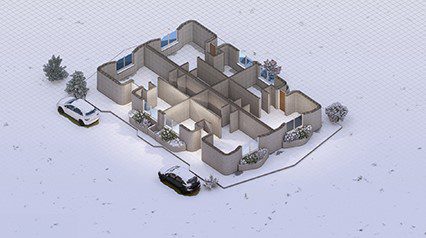
Work on the foundations has already begun and by Oct. 16 the printer will begin running on the 3D concrete layers that will be used to construct four fourplexes on the Siksika Nation.“I’ve been thinking about using the technology to build housing out here and it sort of went from there and to putting together a proposal and getting funding and then ultimately starting to build the project,” said Ryan Hall, housing manager of Siksika Housing on the southern Alberta First Nation.
3D concrete printing technology—a method to create a three-dimensional object layer-by-layer–has been around for about a decade, he says. In the last few years, it has become more commercially viable.
This past summer, Hall began talking with nidus3D, a Kingston, Ont.-based company that does 3D construction. On the strength of that partnership, the University of Calgary School of Architecture and Planning was drawn into the project and the three worked together to develop the 16 transitional units.
The exterior walls for the fourplex are constructed using 3D concrete printing technology. (Rendering provided)Kakatoosoyiists, which means Star Lodges, will be the largest 3D concrete printed housing project in Alberta.
The 3D printer operates on site. A robotic arm, directed by railings that have been installed on site, layers the concrete where it is required. The exterior walls will be laid on top of a concrete slab-on-grade foundation.
Hall said they had considered using the 3D technology for interior walls, as well, but opted to go with conventional walls inside. It’s less print time, he says, and saves money.
The print time to do the exterior walls is about one week per building.
Electrical, plumbing, windows and finishing work will then be undertaken.
“We’re still trying to figure out some supply chain issues to acquire materials, but I think in the new year, they’ll be ready. Our contract requires that they are done by March 31,” said Hall.
Kakatoosoyiists will consist of 16 one-bedroom-one-bathroom units grouped in fourplexes. Each unit will be about 600 square feet. They will serve as homes for single or double occupation. Double occupation could be partners or a mother and child.
As transitional homes, they could be occupied from six months to two years, says Hall.
The units are intended for Nation members who are experiencing a housing crisis, whether they are moving back from Calgary because they can no longer afford the rent or they are fleeing domestic violence.
“Whatever it is, they’ll have supports in place that could be done through home visitation or maybe providing them a service (to help) them move into permanent housing,” said Hall.
As for permanent housing, Hall says that’s a three-to-five-year plan which will see Siksika Nation build three- or four-bedroom homes.
There is a possibility that 3D printed concrete technology could be used there too as it would provide a faster turn around. A company can be hired to do the work or the Nation could look at undertaking the work itself.
“I would consider this a pilot project,” said Hall. “And one of the ideas is, if it makes sense to us after we’re done, and I’ve done sort of an analysis on this, maybe the nation would buy a machine and actually design and build our own housing.”
Using their own design will allow Siksika Nation to incorporate Blackfoot knowledge, which is exactly what Kakatoosoyiists has done with Elder Eldon Weasel Child having input.
The roof is designed to look like a tipi, with wood beams projecting like tipi poles. Inside, there are interior spaces in the bedrooms to accommodate sacred bundles as sacred bundle holders may someday be residents. There is also a gathering area off the main entrance.
Hall says their innovative construction project is garnering some attention from Indigenous communities in Alberta, especially, because they are able to get input from Elders to design the homes, which is not something that can be done with prefabricated homes.
3D printing technology also provides for a sustainable way of building as it minimizes waste, reduces carbon emissions, and utilizes locally sourced materials.
Hall says he had no problems convincing chief and council to embrace the cutting-edge technology, especially since service sites were already available. A band council resolution was required for the funding application.
The project is funded at $2.6 million from Indigenous Services Canada.
Local Journalism Initiative Reporters are supported by a financial contribution made by the Government of Canada.
Alberta’s largest 3D-printed housing project will create Star Lodges
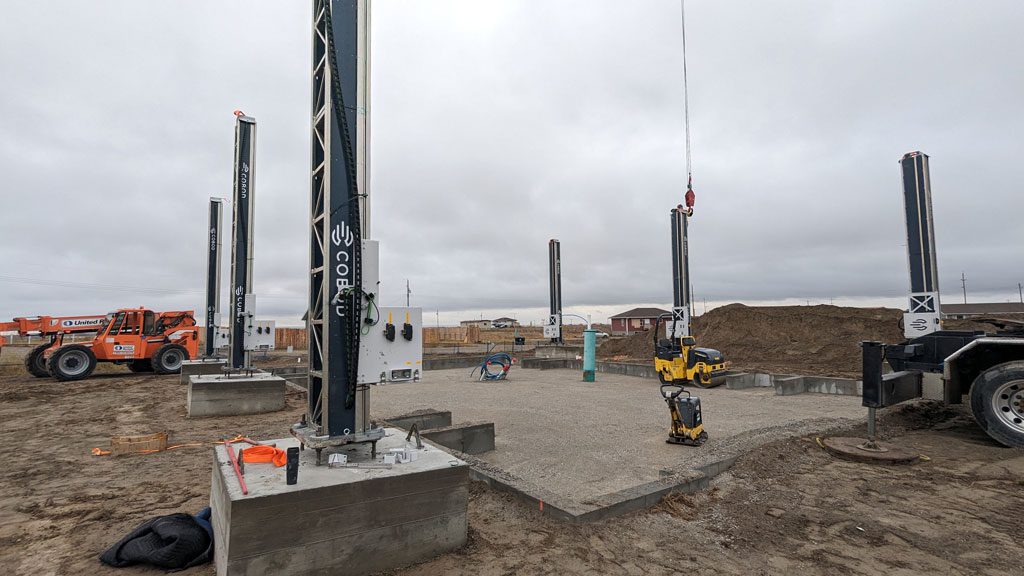
On a muddy, brown construction site at Siksika Nation, a community of 7,800 an hour’s drive east of Calgary, the foundation for the largest 3D-concrete-printed housing project in the province is slowly taking shape.
Crews have backfilled the foundation while the gantry for a printer has been set up and a batch plant has been installed onsite. Soon, a robotic arm will begin layering exterior concrete walls for the structure.
The walls will be laid on top of a concrete-slab-on-grade foundation to create transitional housing units for members of the community who may be in crisis due to fleeing domestic violence or moving from Calgary.
“We are just about to complete the first foundation and slab,” says Ryan Hall, housing manager at Siksika Nation. “Printing of the first building is expected to begin on Oct. 24.”
The buildings, called Kakatoosoyiists, which means Star Lodges, will consist of 16 one-bedroom, one-bathroom units grouped in fourplexes. Each unit will be about 600 square feet. Completion will be in April.
“The exterior walls of the fourplexes are 3D-printed,” explains Hall. “The foundation and slab are conventional construction, as well as interior separation walls.”
The 3D printer operates onsite. A robotic arm puts down layers of concrete where it is required.
The project is funded with $2.6 million from Indigenous Services Canada. Crews from nidus3D of Kingston, Ont. are laying down the concrete foundation. Cost of each unit upon completion is about $162,500.
The University of Calgary School of Architecture and Planning is working with nidus3D and the community to develop the units. Prof. Mauricio Soto Rubio, associate professor of architecture, and his students, are part of the architectural and consulting team advising on the build throughout construction. They came up with the architectural drawings and are assisting with trades onsite.
The roof of the structure has been designed to look like a Blackfoot tipi, with wood beams projecting like tipi poles. A knowledge keeper and elder from the community were engaged to help with the design.
The idea for the project came about because it seemed like a good fit for the type of housing that’s needed – and 3D-concrete-printed housing uses less labour.
“The primary reason is due to the labour bottleneck,” says Hall. “We are challenged with access to trades, and 3D printing allows us to build a lot of the structure using a robot with minimal staff. The technology makes a lot of sense for remote locations. Other reasons include structure longevity, and the ability to design for the local culture.”
Siksika Nation had been searching for new and innovative ways to build housing in the community. While 3D concrete printing technology has been around for about a decade, it’s only become more commercially viable in the last few years.
“The funding and timing of this project was perfectly aligned to build it now,” says Hall. “Additionally, we are in a severe housing crisis and we need to act now.”
Meantime, Hall had been working with the University of Calgary on ideas for housing designs for the community, with the goal of reducing the number of workers needed.
“One of the ideas proposed by students was a 3D-printed housing concept,” he says. “I put together a proposal to Indigenous Services Canada to pilot the technology, and we were approved to begin immediately.”
To build the walls, concrete flows through a print head which builds layer upon layer. Each fourplex is expected to take a maximum of a week to print.
Builders had thought about using the 3D technology for interior walls but decided to go with conventional walls.
Once the walls are up, crews will do the electrical and plumbing work, install windows and do the finishing work. The community is planning to hire mostly local Siksika Nation contractors for the jobs.
Hall says the project has gone smoothly so far but it may be tricky getting the printer to work during winter.
“The main challenge (is) winter construction. The printer will not operate correctly under about 5, so we have worked with a tent company to provide a shelter for each building site with heating. This will be the first 3D project that has done so, to my knowledge. The concrete supply has not been an issue.”
Hall plans to make the business case for the Siksika Nation to buy a 3D concrete printer so the community can design and build its own housing.
“It presents an economic development opportunity for the nation. In the past, we have bought primarily off-the-shelf designs for ready-to-make units that are built in a factory, which is very convenient but presents challenges in that, like many on-reserve houses, eventually succumb to mould and wear and tear.
“3D concrete houses help us extend the life of the homes – and for these reasons we are getting a lot of interest from other nations suffering from the same issues,” he says. “In addition, we can create employment for nation members by adopting the technology.”
9 Examples of 3D-Printed Houses
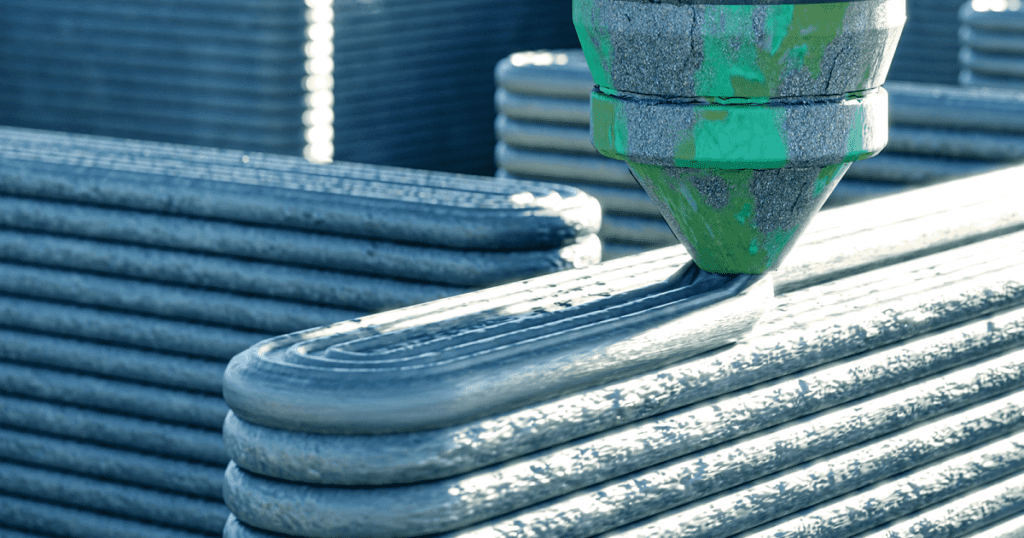
It’s a rare occasion when something debunks the “too good to be true” principle, such as 3D printing an entire house in less than 24 hours. And yet, here we are.What Are 3D-Printed Houses?Three-dimensional-printed houses are structures that are built layer by layer using an industrial-grade, 3D-printing technology. This method of additive manufacturing is also known as construction 3D printing.As tenants move into 3D-printed houses in the first years of their commercial listing debut, 3D printing is on a 23 percent compound annual growth rate over the decade to come, according to Grand View Research. These dwellings — often sharing a gray, shapely appearance with a ribbed texture — are even piquing the interest of NASA, which funded a $57 million project to develop tech for moonside 3D-printed infrastructure.Highly customizable and free of form, construction 3D printing is a new-age tech on the verge of market disruption, holding the potential to mass produce housing.What Are 3D-Printed Houses?Three-dimensional-printed houses are life-size dwellings that use 3D printing as its primary means of construction. With minimal human oversight, these highly customizable structures can be built on-site or off-site within a matter of hours at a fraction of the cost.Typically, 3D-printed houses feature free-form, curvilinear shapes made out of a cement mix. Projects span from inhabitable beta prototypes under study to move-in-ready affordable housing and even high-end luxury homes.Aside from time and money, several other reasons explain additive manufacturing’s disruption to the construction market. Many see this type of low-waste, computerized homebuilding delivered from an industrial-scale printer as a way to shelter unhoused communities and a gateway to sustainable, biodegradable housing solutions.How Are 3D-Printed Houses Built?Industrial-sized 3D printers build entire multi-unit housing developments one tiny layer at a time. This repetitive process puts the “additive” in “additive manufacturing.”Following a digital blueprint, a 3D printer will dispense a paste-like mixture. This will consist of choice ingredients — often a cement blend — but can range from sand and special polymers to bio-resins, like soil, clay or wood flour, which is a fine sawdust mixed with a corn-based binder.How Long Does It Take To 3D Print a House?Nowadays, industrial-sized 3D printers have made it possible to print an entire house in less than 24 hours.Keep in mind that a project’s “printing time” may exclude time for any second-fix installations or construction time necessary to piece together a project printed on-site and transported to its final location.And if you’re trying to build something of scale, like a house, the 3D printer itself has to outsize it. Made out of a steel, quad-truss framework — the kind you’d see as part of a concert stage — these industrial-grade 3D printers form a sort of hollow cube. On top, a robotic arm zips along a track, following pre-programmed instructions being read from the blueprint.Much like your desk-side inkjet printer, the mixture is then heated during a thermal extraction process. The paste squeezes through a nozzle, bringing the digital rendering into physical form. Before the next layer is applied, the mixture is solidified by a concrete dryer. This process repeats until all uploaded building elements are complete.It’s important to note that additive construction work sites are not entirely autonomous. Aside from the setup and breakdown of the equipment, human oversight is necessary to ensure there are no technical hiccups. Specialists must be on-site to cut holes for second-fix installments, such as plumbing, electrical wiring, doors and windows.How Much Does a 3D-Printed House Cost?Of course, this number will vary from project to project, and face further price contingencies based on the hired companies and materials used (let alone geographic location, size, amenities, design complexity, and so on). With that being said, developers stateside and abroad report average cost savings of 30 percent.Three-dimensional-printed houses first hit the U.S. market at the start of 2021. The 1,407-square-foot house — complete with three bedrooms, two baths and a two-car garage in Riverhead, New York — listed as “the world’s first 3D-printed home for sale” for $299,999 on Zillow.com.ICON, a 3D-printing construction company, said it could produce a 600 to 800-square-foot, economy-sized building for as low as $4,000 in 24 hours, as reported by Business Insider.Models on the more affluent side of the market can surpass $1 million. Known as House Zero, the mid-century, ranch-style luxury home is a 2,000-square-foot property with a 350-square-foot accessory dwelling unit. Just based on size and location, Zillow estimated the price of this four bedroom, three-and-a-half bath estate at $723,000 to $908,000, according to online specialty magazine All3DP. However, its one-of-a-kind, exceptional design may push it into the seven-digit price range.When Will 3D-Printed Houses Become Available?Examples of 3D-Printed Houses[embedded content]An error occurred.Unable to execute JavaScript. Try watching this video on www.youtube.com, or enable JavaScript if it is disabled in your browser.BioHome3D is a 3D-printed house constructed out of 100 percent bio-based materials. | Video: 3DPrint.comBioHome3DThe University of Maine Advanced Structures and Composites Center is 3D-printing housing structures exclusively from bio-resins and wood fibers to combat labor shortages and widen access to affordable housing. The demo project, known as BioHome3D, begins with a 600-square-foot prototype that features a fully 3D-printed floor and roof. As a whole, the one-bedroom, one-bathroom building is 100-percent recyclable, made up entirely of biodegradable materials, including wood flour. As a prototype, BioHome3D is equipped with monitoring sensors, measuring thermal, environmental and structural elements, to gather resilience-based data to better inform future designs.[embedded content]An error occurred.Unable to execute JavaScript. Try watching this video on www.youtube.com, or enable JavaScript if it is disabled in your browser.All East 17th Street Residences feature minimal architectural aesthetics. | Video: FindYourDENEast 17th Street ResidencesThese four Austin, Texas properties by construction 3D-printing company ICON feature open-floor plans, minimal architectural aesthetics and private yards. Varying in size, these residences feature two to four bedrooms and range from 1,000 to 2,000-square-foot homes. Each ground floor level is built with a proprietary cement-based material, dubbed “Lavacrete,” to last longer than traditional construction materials, according to the company’s website. The second story incorporates old-school methods, and is constructed out of black metal cladding and rich-colored timber. They share a color palette of green, white and terracotta and have all been sold.[embedded content]An error occurred.Unable to execute JavaScript. Try watching this video on www.youtube.com, or enable JavaScript if it is disabled in your browser.Mikkel Brich, CEO and founder of 3DCP, talks about the future of 3D-printed construction. | Video: COBODHouse 1.0With the help of 3D-printing construction manufacturer COBOD, Danish startup 3DCP Group constructed Europe’s first 3D-printed tiny house last year in just five weeks; however, the structure itself printed in just 22 hours. Located in Hostelbro, Denmark, this 398-square-foot structure is composed of three sections that merge at an open, triangular-shaped core. Inspired by the no-frills aspect of student living, the space is economically laid out and contains all the necessary amenities — a bathroom, open-plan kitchen, living room and loft-style bedroom on a raised level. Sebastian Aristotelis, architect at Saga Space Architects who designed House 1.0, said that the project was built at the lowest possible cost, with developers opting for inexpensive materials, like concrete, and constructing the project using a low-to-no waste approach.More on 3D Printing 25 3D-Printing Companies to Know[embedded content]An error occurred.Unable to execute JavaScript. Try watching this video on www.youtube.com, or enable JavaScript if it is disabled in your browser.Watch 3D-printing construction company ICON build House Zero, a luxury 3D-printed house. | Video: ICONHouse ZeroICON teamed with architectural firm Lake|Flato to build a three-bedroom, two-and-a-half bath residence just outside of downtown Austin, Texas. Its curved walls and rounded corners are insulated with Lavacrete and reinforced with steel. Paired with a one-bedroom, one-bath accessory dwelling unit, ICON’s website styles the 2,350-square-foot property — which printed in under two weeks — as a “mid-century modernist ranch house aesthetics.” Given its design to consume net-zero energy, Time named House Zero to its Best Inventions of 2022 list. In the months since, ICON has broken ground on a 100-home project, projected to be the largest 3D-printed residential community in the United States.[embedded content]An error occurred.Unable to execute JavaScript. Try watching this video on www.youtube.com, or enable JavaScript if it is disabled in your browser.Kamp C was built in one piece. | Video: Kamp CKamp CIn just three weeks, Belgian company Kamp C 3D printed its namesake demo house in one piece, at the property location. Developers claim that the building holds a compressive strength three times greater than conventional brick, which is largely credited to a special printer supplied by COBOD, a 3D-printing construction company. Smooth surfaces and thick layers fortify the trial model. Unlike other projects at the time — and even now — this house features two stories and was constructed in one piece. It’s just under 27 feet tall, about the size of a residential telephone pole, and spans 967 square feet. Its sustainable design uses low-energy floor and ceiling heating, sourced from solar panels and a heat pump.[embedded content]An error occurred.Unable to execute JavaScript. Try watching this video on www.youtube.com, or enable JavaScript if it is disabled in your browser.Mense-Korte is the first 3D-printed house to pass the building regulations of a national government. | Video: The B1MMense-KorteMense-Korte’s 3D-printed house, located in Beckum, Germany, is the first in the world to become fully certified by a national government’s building regulation. This modernist, three-bedroom, three-bathroom home measures 1,722 square feet of living space, complete with a sophisticated interior and smart-home technology. Fortified by multi-shell walls casted with in-situ concrete, the curvy structure took nearly eight months to build, including 100 hours of active printing time. Amenities like a fireplace, bathtubs and a balcony are integral to the design, with spaces specifically molded for second-fix installations.More on 3D Printing Utility 5 3D Printing Applications in Construction[embedded content]An error occurred.Unable to execute JavaScript. Try watching this video on www.youtube.com, or enable JavaScript if it is disabled in your browser.The Quatro residences are built to consume as much energy as they generate. | Video: Mighty BuildingsMighty House QuatroNestled away in a gated, hilltop community in southern California, Ehrlich Yanai Rhee Chaney Architects have built a 20-home, net-zero development that aims to consume as much energy as it generates. Constructed in around four months, each home includes two bedrooms and two bathrooms across a 1,171-square-foot space built on top of a hot spring aquifer. Fitted in a modern, minimal aesthetic, these properties include a swimming pool, hot tub, fire pit and floor-to-ceiling windows. The project collaborator, construction company Mighty Buildings, models its manufacturing process after the automotive industry. Operating highly scalable micro-factories, its 3D-printing methods perform at twice the speed of traditional construction, and, as an additive manufacturer, its projects generate 99 percent less waste, according to the company’s website. Mighty Buildings has also developed a proprietary light stone material that cures into a stone-like composite with four times the tensile and flexural strength of concrete materials currently in common practice of architectural 3D printing.[embedded content]An error occurred.Unable to execute JavaScript. Try watching this video on www.youtube.com, or enable JavaScript if it is disabled in your browser.Project Milestone was printed in five days and 24 separate parts. | Video: Real Estate & Interior Design Project MilestoneProject Milestone — which consists of five 3D-printed concrete dwellings — was the world’s first commercial housing project in its medium, with full intent to legally house residents. The first of these 1,011-square-foot dwellings was printed in 120 hours on-site as 24 separate parts. Matching their backdrop of Eindhoven, a techy city in the Netherlands known for its cutting-edge design, Project Milestone houses resemble elongated boulders with smooth, rounded edges. With extra-thick insulation and a connection to the heat grid, these structures score high marks in energy efficiency, according to online media platform 3D Natives. Its first tenants, Dutch couple Elize Lutz and Harrie Dekkers, received their key on April 30, 2021.[embedded content]An error occurred.Unable to execute JavaScript. Try watching this video on www.youtube.com, or enable JavaScript if it is disabled in your browser.Sourced from local clay, Tecla serves as a proof of concept for sustainable architecture. | Video: WASP TeamTeclaIn development with 3D-printing firm WASP, Italy-based studio Mario Cucinella Architects set out to create bioclimatic, low-carbon proof-of-concept housing in response to escalating climate emergencies and housing crises worldwide. Standing out from the crowd, Tecla’s tan, double-dome structure is constructed out of 350 layers of locally sourced clay from a nearby riverbed. A portmanteau of “technology” and “clay,” Tecla is a 538-square-foot structure that stands at about 15 feet tall and features two skylights. The eco-habitat is made entirely out of organic, bio-materials. Of the 200 hours it took to fully construct the project, the active printing time lasted 72 hours.How much does a 3D-printed house cost?3D-printed houses cost about $10,000 to $400,000 on average, but pricing can vary based on the house’s location, size, amenities and materials used.How long does it take to 3D print a house?To 3D print a house, it may take about 24 hours to three weeks, excluding time for second-fix installations or material transportation if pieces are not printed at the final house location.Where can I buy a 3D-printed house?Some real estate marketplaces like Zillow, or some homeownership assistance programs like Habitat for Humanity, can sell 3D-printed houses.